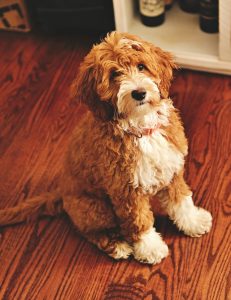A dog losing hair is regrettable since it will affect its appearance. Additionally, besides the fur ending up everywhere, it is more regrettable if some of your family members or even you are allergic to the fur and pet dander. Also, some children may ingest it unknowingly.
Is a dog losing hair on its back a normal condition or not? To speak the truth, it is okay for this pet to lose some amount of fur anywhere. In certain scenarios, it can be much of it or just a little. However, hair loss that results in conspicuous patches in this pet’s coat should not be ignored.

According to Dr. Becker of healthypets.mercola.com, “it's extremely common for dogs with itchy skin to develop hair loss in areas where they've been obsessively scratching, licking, pulling or biting.”
Note that your pet’s coat (hair and skin) says a lot about his or her overall health and this coat is prone to many health conditions such as infections or even parasite infestation. Therefore, fur falling off may be normal or a symptom of various health issues.
Contents
Symptoms of dog shedding hair
Unless it happens in small amounts, the dropping of hair off dogs often indicate an underlying condition and the symptoms accompanying this condition will depend on the exact causes.
Some of the common symptoms that might accompany this hair loss may include the following.
- Compulsive scratching, licking, pulling or biting of its coat - often if its skin is itchy.
- Smelly skin, especially, in the case of infections
- Presence of dandruff
- Bald red pots on the back or affected area
- Presence of scabs
- Lethargy i.e., your pet may not be as playful and energetic as usual.
The exact symptoms and severity will depend on the underlying cause and the after-care measures. Also, if this animal is dull and loses a lot of furs, you should promptly visit a veterinarian for its health to be checked.
Causes
This shedding of hair is medically referred to as alopecia and it can be due to the following factors:
1. infestations by parasites
Hair loss in these pets many times occur due to parasite infestations. Mites, fleas, lice or ticks may prompt irritation on a dog's skin when they suck blood or burrow underneath the skin.
If this happen, this animal will tend to scratch, bite or lick the affected area to soothe the irritation or itchiness. During the process, a significant amount of fur may be plucked off.
Again, these parasites could result in allergies that may cause rashes and scabbing and you will end up with a dog that is losing hair and has scabs on its back.
Consider grooming this pet often. Remove any ticks using tweezers. Fleas can be removed using various products including medicated shampoos and other natural product such as cedar oil.
If you do not seem to find a way to get rid of these parasites, let your vet give you prescriptions will also help to get rid of parasites.
2. Allergies
Secondly, hair shedding that occurs alongside scratching or biting could be due to allergies. Talk of food allergies, environmental allergies, and medication allergies. All these can cause this problem.
In case of allergies, temporary alopecia may occur when these animals scratch or bite the coat. This could lead to swelling, skin breakages and scabs as healing begins. Some allergic reactions can also cause skin blistering.
Afterwards, the scabs will shed off together with some amount of fur. This will leave behind red or the bald patches.
On the other hand, some allergies may result in rashes on the dog's skin. If such rashes are scratched, they will break, open, and they could be infected forming wounds. As the wounds heal, they will as well form scabs that will shed away together with hair.
3. Genetics
Have you heard of hairless dog breeds? Well some breeds such as Chinese Crested, the Xolo (Mexican hairless) and the American Hairless Terrier are examples of hairless breeds. This is normal, and nothing is wrong with such breeds.
On the other hand, there are those varieties with inherited alopecia. This can occur on the back, chest, thigh, legs and many other areas. Some of these breeds include the Doberman Pinscher, Chihuahua, Dachshund, Whippet, and Italian Greyhound.
When caused by genetics, there are treatment options or medication. However, it is advisable you use sunscreens for your pet to prevent skin ulceration and sunburns especially during sunny seasons.
4. Hormonal imbalances
Dogs undergo some hormonal changes during puberty, lactation, pregnancy or after being neutered. Some of these changes may result in bald spots anywhere in the body including on the back, back legs or near tails, etc.
Hormonal imbalances are the main reason for alopecia in aged dogs.
In case of alopecia triggered by hormonal changes, the bowwowinsurance.com.au, notes that "hormonal causes of dog hair loss resolve themselves in most cases and do not require any intervention.” Nevertheless, you should seek advice from a vet in severe cases.
5. Fungal infections
Dog hair loss could also be a sign of fungal infection. If your pet has a weak immune system, then is she or he is likely to be a victim.
Fungal infections including ringworms may cause bald patches after scabbing and healing. If you suspect the fur shedding is due to fungal infection, talk to your vet for prescription.
Your vet may recommend appropriate oral or topical antifungals to treat these infections.
You are also required to disinfect their bedding, and any other thing that they had come in contact with to prevent reinfection or spreading of the fungal infections.
6. Medical conditions
A dog losing hair on back or anywhere elsee can also be due to medical conditions. These conditions include Cushing's disease, hypothyroidism, Addison's disease, and alopecia X among others.
Always seek for medical attention in case of unexplained alopecia. Some of these conditions can be life-threatening.
Therefore, if the fur shedding is not due to genetics, minor skin injury or the usually grooming then you should visit a vet for proper treatment.
7. Nutritional deficiencies
Poor diet can also cause fur loss in dogs or even a dull coat. As a good pet owner, you must know how to mix raw food and commercial food to ensure your dog has a nutritionally balanced diet.
If you are a new owner, get nutritional advice from a vet. This will help you to properly balance your dog's diet to prevent baldness among many other diet-related conditions and diseases.
Also, consider vitamins, minerals, and biotin supplements to help boost this animal's health and coat. A dog savvy vet should help you decide on the right diets for these pets.
8. Certain medications
This problem can also be due to certain treatments and medications which can include oral, topical as well as injectable drugs (or vaccinations).
For instance, high doses or prolonged use of medications such as corticosteroids can also result in alopecia. Talk to your vet when you notice symptoms of dog alopecia after you begin giving these pets certain medication.
9. Stress
In dogs, stress can lead to hormonal changes that cause bald spots and fur shedding.
Various things can cause stress to these pet including when he or she is introduced into the environment, scared, or when a partner has been taken away, among other causes.
Seek advice and help from dog behaviorist to help minimize instances of stress as well as help you know what caused the stress. For instance, according to bowwowinsurance.com.au, “pheromone sprays and collars like ADAPTIL can help the dog to become more relaxed.”
10. Other causes
Your pet can also lose hair due to constant scratching as a result of Osteochondritis Dissecans (OCD). “This will mean that your dog continually scratches, having convinced themselves that it’s the only way they will be able to soothe their anxiety,” says petcarrierverdict.com.
Bacterial infections and changes in seasons can also cause alopecia in these animals.
My dog has scabs on the back and is losing hair
Scabs usually form after a wound or blister begin healing. They can occur due to various reason. These include skin injuries, acne, infections, and many other factors.
Although healing is a good thing, the scabbing will shed away together with a significant amount of fur.
Therefore, to reduce much shedding, you can use a natural product such as olive oil among other products to soften the scabs before they shed. This can relatively reduce the amount of fur lost as the scabs shed off.
Dog losing hair on the back near the tail
A dog losing hair on the back near tail could be due to the various reasons we have discussed that affect the back too. Things such as allergies, hypothyroidism, parasites, infections all can lead to loss of hair in this particular area or anywhere else.
Also, dog stud tail can cause hair loss near the tail base. You might not be able to tell what the cause is unless you are an expert.
Therefore, proper diagnosis is necessary if you need correct prescriptions and treatments. Do not just try anything you learned on the internet unless there has been a diagnosis by a vet.
Natural treatments
Alopecia in these pets can also be addressed by some of the natural products. However, you should only use them in mild cases.
Cases of allergies, parasites infestations, and fungal infections can be treated used apple cider vinegar, lemon juice, olive oil, coconut oil, baking soda or aloe vera. Although the efficacy of these treatments has no solid scientific backing, they can actually help in mild cases and many people have reported positive results.
Summary
In case of abnormal fur shedding, baldness or patchy hair loss, our best advice is to seek help from a vet. He or she will conduct some diagnostic tests to determine any underlying cause and recommend the right treatment.





Sylvia Boronski
Nowhere in these comments are NEEM or KARANJA OILS mentioned.
I have used both tgese products dikuted with pure virgin olive oil for fleas, mites, fungas, and mange with very good results; also, on red, sore, and swollen back legs that I was told was from food allergies. (did not change food, just rubbed in the oils = another good item is quasia amara cream.